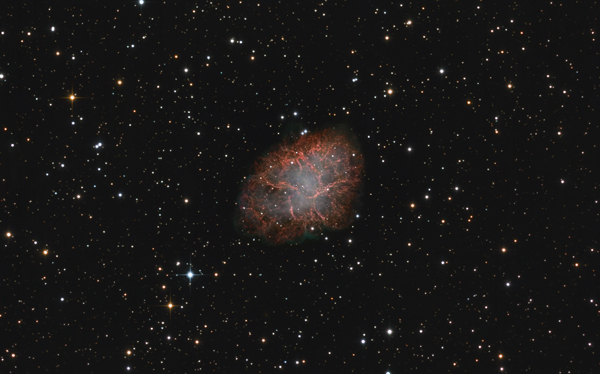
RA: 05h 34m 31s Dec: 22° 00' 52, Mag: 8.4 , Size: 8.0', Distance: ~6,500 ly

RA: 05h 34m 31s Dec: 22° 00' 52, Mag: 8.4 , Size: 8.0', Distance: ~6,500 ly
From Wikipedia, the free encyclopedia
Chandra, Hubble, and Spitzer image NGC 1952. The Crab Nebula (catalogue designations M1, NGC 1952, Taurus A) is a supernova remnant and pulsar wind nebula in the constellation of Taurus. Corresponding to a bright supernova recorded by Chinese astronomers in 1054, the nebula was observed later by English astronomer John Bevis in 1731. At an apparent magnitude of 8.4, comparable to that of the largest moon of Saturn, it is not visible to the naked eye but can be made out using binoculars under favorable conditions. At X-ray and gamma ray energies above 30 keV, the Crab is generally the strongest persistent source in the sky, with measured flux extending to above 10 TeV. Located at a distance of about 6,500 light-years (2 kpc) from Earth, the nebula has a diameter of 11 light years (3.4 pc, corresponding to an apparent diameter of some 7 arc minutes) and expands at a rate of about 1,500 kilometers per second (0.5% c). It is part of the Perseus Arm of the Milky Way galaxy. At the center of the nebula lies the Crab Pulsar, a neutron star 28–30 km across with a spin rate of 30.2 times per second, which emits pulses of radiation from gamma rays to radio waves. The nebula was the first astronomical object identified with a historical supernova explosion. The nebula acts as a source of radiation for studying celestial bodies that occult it. In the 1950s and 1960s, the Sun's corona was mapped from observations of the Crab's radio waves passing through it, and in 2003, the thickness of the atmosphere of Saturn's moon Titan was measured as it blocked out X-rays from the nebula
| Location & Date | Dragon Rock Observatory (DRO), Sacramento Mountains Astronomy Park, New Mexico |
| Telescope |
A&M 360mm R/C F/8, Paramount ME, Prime Focus,
Image scale 0.64 arcsec/pixel |
| Camera |
FLI IMG-6303 w/CFW7 Custom Scientific Ha RGB Filters CCD temp -35°C |
| Exposure Times | (Ha)9x30m, (OIII)5x15m & 5x30m, (R)9x15m, (G)9x15m, (B)10x15m Bin 1x1 |
| Other Information |
Image planning - CCD Navigator Image acquisition/focus/guiding/dither - CCD Commander CCDSoft/TheSky6 |
| Image Processing |
* Images Plus- Calibration, Normalize, Alignment, Sigma Avg Combine, RGB combine, Deconvolution, DDP * Adobe CS4 - Ha+R,GB combine, Levels, Curves, Sharpening, Noise reduction, JPEG conversion * CCDStack - Deconvolution |